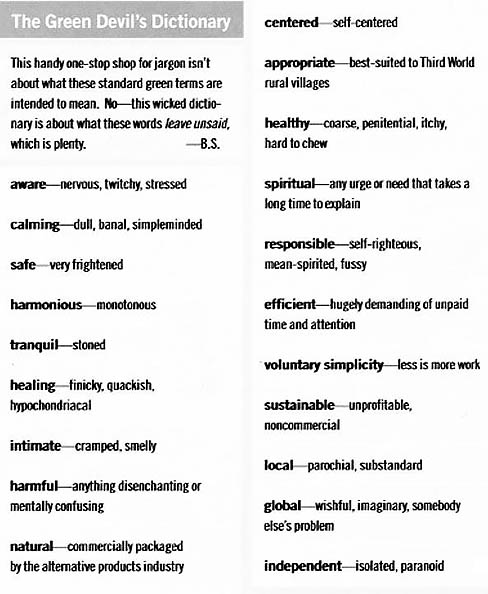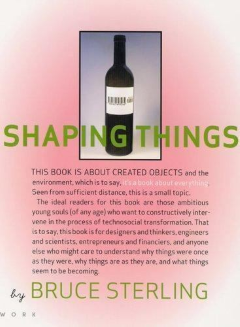No, the caps are not for emphasis. The WELL is a very early digital community, still extant, that sprung out of the keyboards of the founders of the Whole Earth Review, Stewart Brand and Larry Brilliant, in 1985, a long time before people started talking about “the net.” The name WELL stands for Whole Earth ‘Lectronic Link. It’s self-described as being “widely known as the primordial ooze where the online community movement was born.”
It’s what the internet should have become. The fact that it still exists is somewhat startling.
I first stumbled onto (into?) the WELL via one of my virtual – and unbeknownst to him – mentors, the science fiction writer cum futurist Bruce Sterling. In those two overlapping roles, he manages to combine two of my life interests.
Sterling was an early member of the WELL, which became a vehicle of sorts for his futurism. (That’s probably oversimplifying things.) In a 1998 talk, he launched the Viridian movement, where he defines a different hue of the green movement. Speaking in a tone that was a cross between self-deprecating humor and intentional hubris, he wrote:
People are going to demand from me to know what the future holds, and I am going to be fully briefed and in total command of my material. I will coolly and meticulously detail the future for them, in chapter and verse, with principles, subtexts, and policy recommendations. In the highest tradition of my futurist craft, I will be often wrong, but never in doubt. I feel a deep necessity to meet the need here, I consider this my moral duty.
And he anointed himself the “Pope-Emperor.”
Two days after the millennium began (yes, I know that was technically 2001, but who’s counting?), he published the Manifesto of the Viridian movement. He launched it on January 3rd because:
On January 1, everyone will be too hung over to read manifestos; on January 2, nobody’s computers will work. [Anyone remember Y2K?] So naturally the target date must be January 3.
Here’s a tidbit from the Manifesto that will make you either cry or cringe:
We have a worldwide environmental problem. This is a truism. But the unprecedentedly severe and peculiar weather of the late 1990s makes it clear that this problem is growing acute. Global warming has been a lively part of scientific discussion since at least the 1960s, but global warming is a quotidian reality now.
About a third of the way down, he gets to the core.
Society must become Green, and it must be a variety of Green that society will eagerly consume. What is required is not a natural Green, or a spiritual Green, or a primitivist Green, or a blood-and-soil romantic Green.
The world needs a new, unnatural, seductive, mediated, glamorous Green. A Viridian Green, if you will.
So, what does this history lesson (perhaps a “Fractured Fairy Tale”) have to with EcoOptimism? In other words, what does it have to do with me, the EcoOptimist “Pope-Emperor?”
Having met Bruce (I’m going to assume we’re on a first name basis) at a panel I attended at the International Contemporary Fair Furniture back when the fair was more cutting-edge and allowed small fry like my lighting company Fire & Water to exhibit, I exchanged a few emails with him and started following the movement.
At some point, in a Viridian thread someone inquired about eco furnishings for their home. Or at least that’s how I recall it; The emails are long gone. I posted in the thread that what we really needed was a list of green furnishings. I should have anticipated what happened next because Bruce wrote back to me, saying why don’t you do it? It became the Viridian Recommended Furniture list. I titled it “Eco-furniture: A broad and very subjective list.”
It was daunting to write for a movement begun – no, make that owned – by a revered writer. I did my best to be clever. In the intro to that updated version, I wrote:
I titled [the newest entries] in an obvious moment of kowtow to our Viridian Pope: “What if Green Design Were Just Good Design.” But that’s a good thing (the additions, not the brown nosing). It means that eco designed furniture is becoming less like what too many people think all eco furniture looks like. It’s breaking out of its crunchy niche and getting its sustainable teeth into everything.
The quoted phrase was from the title of a column he wrote in 2001 for Dwell magazine. It’s not online but I saved a PDF of it that I used to assign to my students. He started it with “Green design should have won 30 years ago. By now, we should have forgotten all about being green, Greenness should be par for the course….” Taking a cue from that, I put forward the term “Transparent Green,” which I defined as “the green that was there but not shouting it. Perhaps not displaying it at all.” I got some good mileage out of Transparent Green by teaching, writing and speaking about the topic for many years. I stopped referring to it when, happily, green products that didn’t look green became practically the norm.

In “What if Green Design Were Just Good Design,” Sterling wrote “Being green is cranky, fringy and deservedly unpopular.” His “Green Devil’s Dictionary” captures the self-seriousness that greenies sometimes fall prey to.
15 years later, some of my attempted cleverness still seems either moderately clever or painful. I wrote company descriptions such as:
“More artful twigs”
“Celtic and Viking inspired furniture from reclaimed timber. Imagine a Viking interpretation of a tv cabinet — now there’s timeless design”
“Cork furniture. Now you can really be pinned to your seat”
“’Art furniture’ from discarded pallets. Nicer than it sounds.”
Now, in 2020, a vast majority of the companies I listed are no longer there. I guess that signifies the Darwinian evolution of the industry. I tried to have the list taken down a few years ago and Bruce wrote back that no one seemed to have the password. That, combined with the fact that he ended the movement in 2008, must symbolize something. Apologies to my friend Chris Poehlmann who I chastised on the list for still using incandescent bulbs. He’s since seen the light. (Go ahead and groan. I’m only sometimes clever.) But, apparently, I can’t update it. I like it, though, as a page in the history of ecodesign.
I was pretty proud of the list at the time. Now, the great thing is there are so many eco-furniture companies that I couldn’t possibly make such a list because it would take a pile of underpaid interns to help me. And Google can do the work for me. (Just to be clear, I don’t use Google for searches. I use DuckDuckGo cause they don’t spy on you and make sure you don’t get unrelenting ads for something totally embarrassing that you merely looked up once.)
I started this post talking about the WELL and, sort of in keeping with the diversity of the WELL, I’ve no idea how I got started on the topic and how it ended up being almost entirely about Bruce Sterling and the Viridian movement. Or, for that matter, about me.
Bruce: if you’re reading this, go easy on me.


